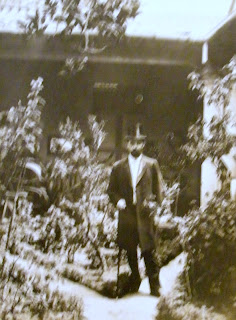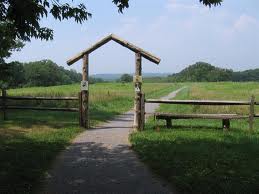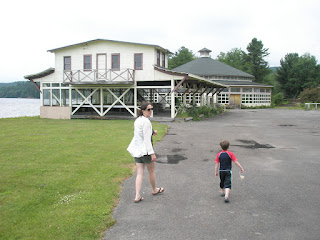The eleven short stories in the newly published collection, Asteronga New York, are undeniably inspired by growing up in Little Falls during the late 1950s and 1960s. But anyone looking for actual models for Uncle Artie, Juliana, Marjorie, Ronnie Van Vranken, Gracie McGee or any of the other characters will be disappointed. No one should search their memories to recall an apparition of the Virgin Mary or a Hungarian boy who rose from the dead. All the people and events in this book are as imaginary as the narrator who tells us about them.
Available in paperback for $9.95.
Asteronga, New York may also be purchased on Kindle for $2.99.
Excerpts from two of the stories
in the collection:
from: " An Appearance of the Blessed Virgin Mary"
I woke up cold, wet and stiff just as the sky
was starting to turn gray. Feeling miserable, I stood under my cousins’ carport
and watched the drizzle for a while, getting my strategy together. I could just
walk into the Selective Service office, I figured, and tell them who I was.
Then I’d act crazy. But what would I say? What could I do to convince them I
was unfit for Viet Nam? The old guys on the Board must have heard the same act
every day. Thousands of guys my age and younger were being called up and about
half a million were over there already.
The death count was up to about forty or fifty names a week. Thinking
about it now, I realize that half the names on the Wall in Washington were
already listed somewhere by then.
The rain continued to come down, getting
heavier, and the sky was solid gray. I noticed the Valley Bus stopping in front
of the closed ice cream store, so without thinking about it any more, I hopped
over the backyard fence and ran to the bus. A half hour later, I looked out the
window of the bus as we passed the Hotel Snyder and rolled to a stop directly
in front of St. Mary’s.
As the bus pulled away toward St.
Johnsville, I looked up at the familiar steeple and decided to just go into the
church for a minute. I felt like seeing the stained glass window where the
children come to visit Jesus. Once I was inside, all the old feelings of my
praying days with little Christina came back to me.
She and her family had packed up and moved
out to California years before but the church was unchanged and completely
empty. The same smell of dust and wood polish and a lingering fragrance of
incense from Benedictions of long ago. I slumped into a back pew, genuflecting
before I knew what I was doing. I had been thinking that I was an atheist but
once I was back in St. Mary’s, the old feelings of devotion rolled up out of
me. I began to pray without any words, just with emotion, letting my feelings
pour out. I discovered that my eyes were
full of tears.
Later that day, after stopping in to say
hello to my parents, I grabbed a pile of camping gear from the attic and headed
up to the woods near Indian Cave. Now that I was back home, my first idea was
to build a hermitage and settle down to some serious praying.
Now, you may be thinking that I had smoked
some funny stuff down in New York City that me right over the edge into
religious mania, but I hadn’t really smoked that much grass and I never took
any LSD or anything like that. I just had an impulse to do some serious praying
on my own. This was not a new idea for me, as I explained earlier. I was always
inclined toward the monastic lifestyle, in a sense.
I settled down that night in the cave,
just rolled up in my sleeping bag and snoring away. Going to the cave probably
was something like going back to the womb. First of all, it was narrow and
dark, hardly a cave at all, more like a cleft in the rocks. The rocks in the
hillside are way too hard to allow for a regular limestone cave full of
dripping stalactites and extending for miles underground like the one Tom
Sawyer and his pals got lost in, but as a kid, Indian Cave had pretty much
defined caves for me.
My brother had introduced me to the cave
when I was only four or five. We played various games in it, mostly some
variation on Cowboys and Indians. I remember once Joe and I went up on the
hillside in the winter and dug down through the snow to find the entrance of
the cave and then we huddled together inside it, looking out at the freezing cold
world outside.
In
the morning, I was a little stiff after two nights sleeping outdoors so I built
a small fire of twigs to warm up and tried a few prayers. All that came to mind
was the Hail Mary and Our Father routine and somehow that didn’t seem to suit
my surroundings. I did some Zen meditation like Jack Kerouac used to write
about, trying to focus my mind but the tweety-tweet singing of the birds kept
distracting me from the Empty Mind thing. I gave up on the spiritual exercises
and went down to Reese’s Mom & Pop store on East Madison and bought a six
pack of Utica Club. By mid morning I had finished the beer and gone back to my
sleeping bag for a nice nap.
When I woke up around noon, my mind was
clear, or at least I thought it was. I decided that I would get my gear
together and walk up through the Adirondacks to Canada. Cramming what I could
into a backpack, I rolled up the sleeping bag and tied it on top of the pack.
Looking around at my campsite, I said a few more prayers and strode off in what
I assumed was a northerly direction. The only problem was that I didn't have a
compass so after I had walked about five miles, I realized that I had been
heading due east.
I was getting tired, after all that beer
and walking and no food, so I sat down on a log and watched the cars skimming
past on Route 5, a road that pretty much directly followed an east-west line up
the Mohawk Valley from Albany to Syracuse.
As I sobered up, the idea of walking the
200 or so miles to the Canadian border grew less appealing. I thought maybe I
would head up a county road from Neary's Bar & Grill, which was visible
through the trees, to the old pond where I could do some swimming and maybe
find a girl. I was so horny that I felt certain I'd meet a very willing girl
down at the rocks. Horniness often induces a state of certainty like that.
About an hour or so later, I made it to
the trail that led down from Clay Hill Road to the flat rocks below the dam.
Only one car, a beat-up ’57 Ford, was parked near the top of the trail.
Scrambling downhill, I fell once, felt like an idiot, and dusted myself off
before going on. I heard some laughing and splashing sounds so I knew I was
getting closer to the flat rocks.
When I was in high school, I used to go down
to the rocks with Mark Halsdap, who’d drive his brother’s El Camino. He'd
invite as many of us as could fit to jump into the back and we'd head off to
the pond.
Usually, somebody would have ID for beer
and we’d arrive semi-drunk and acting like idiots. Mostly, it was a bunch of
guys. We kept hearing stories of girls who would join in the skinny dipping off
the rocks below the dam, but to tell you the truth there were almost never any
girls there. The place was too wild and unsupervised for most of them, except
maybe Gracie Simchak.
That's why I was so surprised when a girl
in a two piece bathing suit came running full speed out of the trees. “Whoa!” I
yelled, “Watch out!” Bam! She crashed right into me, and practically knocked me
over.
“Hey, aren’t you Ellen, Linda’s sister? What’s
up with you?”
I thought maybe she was terrified but I’m
not that good at reading people.
Just then two guys came running like
maniacs, followed by another girl. She was holding the top of a two piece as and
her eyes were wild.. I couldn’t help noticing that she had very nice tits.
“Hey, hold on!” I yelled. “What’s going
on?”
from: "Burying Uncle Artie"
“What killed him the end, anyhow?” asks Paul.
“Wife
called. Said he was running off, again, you know, like I give a shit or could
do anything about it. He was always running off on a drunk. What’s she calling
me for? I never even met her. Some tramp he picked up at A.A., probably.”
This was
a pretty long speech for James, but he wasn’t done.
“So she
calls me again ten minutes later. She says Artie went out to the car. I said,
so? Then she says he started the ignition and let it warm up, like he always
did. He was careful that way. But he never gets to put it into Drive. She sees
him slumped over the wheel, with the transmission still in Park. She opens the
door and he falls out. He’s dead, she says. His heart must’ve gone.”
“All this
in what, ten minutes?” I ask.
“Yeah,”
says James. “She calls me when he’s running out on her, then she calls me and
says he only made it to the car and dropped dead, and she’s got no money, she
goes on, she doesn’t have any cash, she can’t pay for a funeral, can she send
me the body C.O.D. and can we bury him up here.”
“So
what’d you say?” I ask.
“I says yeah, ship the body to Shepardson’s
and we can bury him here.”
“Is she coming?”
“Is she coming?”
“Who?”
“His
wife,” I say. “Is she coming to the funeral?”
“She
didn’t say. She only said she’d send Artie home so I told her okay.”
“Where
are you gonna put him?” asks Paul.
“Up in
Old St. Mary’s. Next to Ma and Pa and Iggie. We got a lot of plots up there. My
old man had foresight. He bought a dozen plots back in the twenties. Room for
all of us, he used to say. One big happy family. That’s what he’d say.”
“I don’t
think they’re allowing people to get buried up there any more.”
“What do
you mean?”
“It’s on
such a steep hill,” explains Paul. “They built that place back in horse and
buggy days. A hearse can’t get up those dirt roads they got. Some of the
gravestones are even falling down the hill so nobody knows who’s buried exactly
where.”
“What are you saying? They’re not burying
anybody up there?”
“That’s what I’m saying. The monsignor says everybody’s got to go to the New Cemetery out on Route Five where it’s nice and flat.”
“That’s what I’m saying. The monsignor says everybody’s got to go to the New Cemetery out on Route Five where it’s nice and flat.”
“The fuckin bastard. The cheap fuckin
bastard.” James is glowering into his beer. “No fuckin way. No fuckin way.”
“What do
you mean, Uncle James?”
“No
fuckin way am I gonna buy a new plot to put Artie in. He belongs with Ma and Pa
and Iggie.”
“Don’t
worry about it,” I offer. “I’ll talk to
the priest.”
I leave
James at the bar. I knew he’d be there the rest of the day. I drove over to the
rectory at St. Mary’s and rang the bell. An old lady answers. The housekeeper.
“ I’d like to see the pastor,” I tell her, so she lets me in and has me sit in
the parlor for about fifteen minutes before this big beefy guy in black pants
and a white T-shirt comes in.
“Hiya,
father,” I say. “I want to talk to you about a funeral.”
“Monsignor,” he corrects me, not offering to shake hands. He knew who I
was, I guess, even though he’d only been here a couple years. He probably noticed how I never dropped by
the church.
“The
funeral director will handle all the details, son.” He never even asks who
died. Maybe he already knows.
“Yeah,
we’re using Shepardson but I wanted to ask you something.” He waits for me to
continue. “I wanted to ask you about Old St. M’s. We got a family plot up
there…”
He raises
his hand, cutting me off. “Interments are no longer permitted in Old St.
Mary’s.”
“I don’t
know, father,” I say. “I got to talk to my mother and my uncle.”
“Monsignor,” he reminds me.
“Yeah,
well so long for now, Monsignor.” How much would this cost, I wonder, and
who’ll pay for it?
I find
James back at the bar and lay out the situation to him. “No fuckin way” is his
response, so I drive back to Dolgeville, where my mother was living that year.
“James is
a stubborn old bastard,” she agrees. “But I see his point. Why should Artie be
all by himself when Ma and Pa are up in Old St. M’s? It’d be like burying him
on a golf course.”
“Yeah,
but the priest says they don’t allow what he calls interments up there anymore.”
“James is
pretty used to getting his own way, that’s all I’m saying,” my mother
concludes. “I’d never cross him.”
Artie’s
body arrived the next day. Tom Shepardson said we could come down and have a
gander. My mother wanted to, so we did. I let her look him over as long as she
wanted, but I took just a quick glance. He looked like he’d been dead for a
year as far as I was concerned. Then Tom took us on the grand tour of
casketville and Mom picked out something middle priced, not cardboard but not
mahogany neither.
“And will
you want to wake him for two nights?” Tom inquires.
“One
should do it,” says my mother. “Not that many people around here know him anymore.”
After
that, we reported to James at the bar. “Sounds okay,” he says to the idea of a
one-night wake and a 9:30 funeral on Wednesday. He would be picking up all the
bills. Since he never spent any money, he had plenty. One time he was driving
along Route 5 with a bunch of uncashed checks stuck up in the visor. He got hot
and rolled down the window and the checks all blew out. He didn’t even stop to
go back and try and find them. He had that much money piled up.
“How
about the cemetery?” he asks. I could see he was ready for a fight.
“Tom says
they don’t bury people in old St. M’s any more.” My mother was assessing James’
reaction, trying to hide a smile. “You heard about that, right?”
“No
fuckin way.”
My mother
turned to me and held out both her hands, palms up. “What can you do? My
brother James is incorrigible.” She was delighted with him and eager, I could
tell, to see what would come of James’
impending battle with the priest.
“Artie
woulda loved this,” she mouths to me.
The wake
went pretty much as might be expected.
His wife never showed. A few old drunks came, a few more old pals of Artie
who were now in A.A., and the two sides went at it pretty good, accusing each
other of being lushes and hypocrites respectively. One old guy comes in, wearing his American
Legion cap, and did a little patriotic service.
“We are going,” he confided in a loud whisper to my mother. “We are
going, Mary, one by one.”
“Better
than two by two” is her reply.
I look
around, trying not to laugh, and I notice that James is nowhere in sight. He
was always restless and the idea of him sitting around next to his brother’s
embalmed body probably didn’t appeal to him. Maybe he’s gone back to the bar, I
thought. Then, to my surprise, he reappears at the door to what the Shepardsons
call the reception room. He was standing there, fidgeting. He didn’t have a
suit jacket or tie or anything. Didn’t own any, I’m sure. He was in his flannel
shirt and overalls, as usual. I eased my way past my mom and the American
Legion guy, who were still chatting, and went over to James.
“Kid,” he
says to me. “I got a couple of bum arms here.”
“Yeah,” I
say. “I know.”
“Otherwise, I wouldn’t put you in a spot like this.” He looks right and
left to see if anyone was near. “Let’s talk out on the porch.”
Once we
were outside, James tells me his plan.
“Here’s
what we do. We’re going up to Old St. M’s.”
“Why?”
“I got a
shovel and a pickaxe in the truck. And a Coleman lantern. “
“Are we
gonna dig somebody up?” I couldn’t figure this out at all.
“We’re
going to dig a grave for Artie, right where he belongs.”












































.JPG)




